| X
THE SUCCESSORS OF GALILEO IN PHYSICAL
SCIENCE
A History of Science: in Five Volumes. Volume II: The Beginnings of Modern Science | ||
10. X
THE SUCCESSORS OF GALILEO IN PHYSICAL
SCIENCE
WE have now to witness the diversified efforts of a company of men who, working for the most part independently, greatly added to the data of the physical sciences—such men as Boyle, Huygens, Von Gericke, and Hooke. It will be found that the studies of these men covered the whole field of physical sciences as then understood—the field of so-called natural philosophy. We shall best treat these successors of Galileo and precursors of Newton somewhat biographically, pointing out the correspondences and differences between their various accomplishments as we proceed. It will be noted in due course that the work of some of them was anticipatory of great achievements of a later century.
ROBERT BOYLE (1627-1691)
Some of Robert Boyle's views as to the possible structure of atmospheric air will be considered a little farther on in this chapter, but for the moment we will take up the consideration of some of his experiments upon that as well as other gases. Boyle was always much interested in alchemy, and carried on extensive experiments in attempting to accomplish the transmutation of metals; but he did not confine himself to
His experiments to prove the atmospheric pressure are most interesting and conclusive. "Having three small, round glass bubbles, blown at the flame of a lamp, about the size of hazel-nuts,'' he says, "each of them with a short, slender stem, by means whereof they were so exactly poised in water that a very small change of weight would make them either emerge or sink; at a time when the atmosphere was of convenient weight, I put them into a wide-mouthed glass of common water, and leaving them in a quiet place, where they were frequently in my eye, I observed that sometimes they would be at the top of the water, and remain there for several days, or perhaps weeks, together, and sometimes fall to the bottom, and after having continued there for some time rise again. And sometimes they would rise or fall as the air was hot or cold.''[31]
It was in the course of these experiments that the observations made by Boyle led to the invention of his "statical barometer,'' the mercurial barometer having been invented, as we have seen, by Torricelli, in
Another of his experiments was made to discover the atmospheric pressure to the square inch. After considerable difficulty he determined that the relative weight of a cubic inch of water and mercury was about one to fourteen, and computing from other known weights he determined that "when a column of quicksilver thirty inches high is sustained in the barometer, as it frequently happens, a column of air that presses upon an inch square near the surface of the earth must weigh about fifteen avoirdupois pounds.''[33] As the pressure of air at the sea-level is now estimated at 14.7304 pounds to the square inch, it will be seen that Boyle's calculation was not far wrong.
From his numerous experiments upon the air,
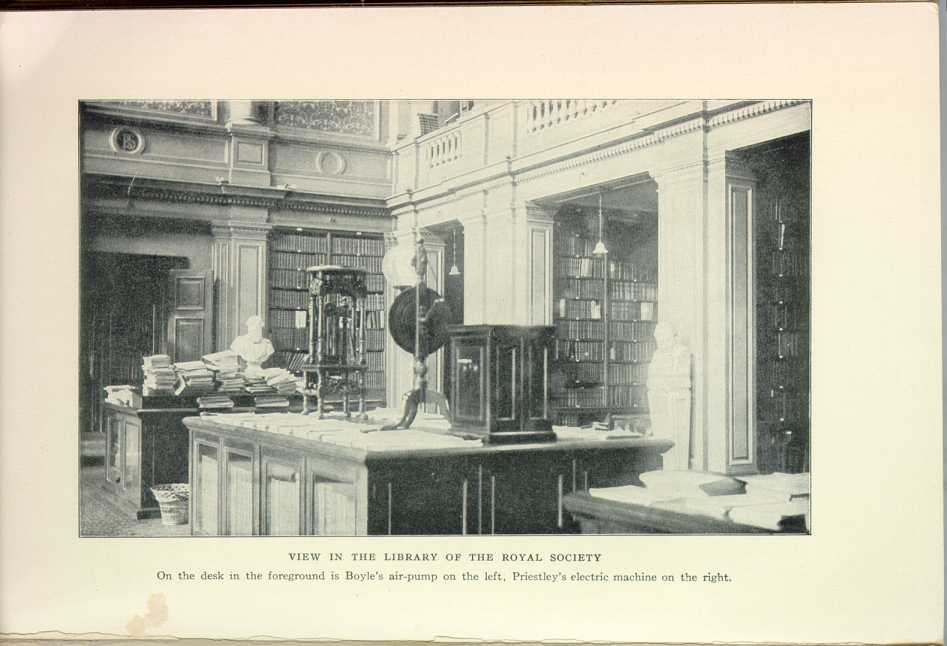
VIEW IN THE LIBRARY OF THE ROYAL SOCIETY
On the desk in the foreground is Boyle's air-pump on the left.
Priestly's electric machine on the right.
[Description: Photograph of the library in the Royal Society. On the
desk in the foreground is Boyle's air-pump on the left. Priestly's
electric machine on the right.
]
Although he was himself such a painstaking observer of facts, he had the fault of his age of placing too much faith in hear-say evidence of untrained observers. Thus, from the numerous stories he heard concerning the growth of metals in previously exhausted mines, he believed that the air was responsible for producing this growth—in which he undoubtedly believed. The story of a tin-miner that, in his own time, after a lapse of only twenty-five years, a heap, of earth previously exhausted of its ore became again even more richly impregnated than before by lying exposed to the air, seems to have been believed by the philosopher.
As Boyle was an alchemist, and undoubtedly believed
Boyle's work upon colors, although probably of less importance than his experiments and deductions upon air, show that he was in the van as far as the science of his day was concerned. As he points out, the schools of his time generally taught that "color is a penetrating quality, reaching to the innermost part of the substance,'' and, as an example of this, sealing-wax was cited, which could be broken into minute bits, each particle retaining the same color as its fellows or the original mass. To refute this theory, and to show instances to the contrary, Boyle, among other things, shows that various colors—blue, red, yellow—may be produced upon tempered steel, and yet the metal within "a hair's-breadth of its surface'' have none of these colors. Therefore, he was led to believe that color, in opaque bodies at least, is superficial.
"But before we descend to a more particular consideration of our subject,'' he says, " 'tis proper to observe that colors may be regarded either as a quality residing in bodies to modify light after a particular manner, or else as light itself so modified
In examining smooth and rough surfaces to determine the cause of their color, he made use of the microscope, and pointed out the very obvious example of the difference in color of a rough and a polished piece of the same block of stone. He used some striking illustrations of the effect of light and the position of the eye upon colors. "Thus the color of plush or velvet will appear various if you stroke part of it one way and part another, the posture of the particular threads in regard to the light, or the eye, being thereby varied. And 'tis observable that in a field of ripe corn, blown upon by the wind, there will appear waves of a color different from that of the rest of the corn, because the wind, by depressing some of the ears more than others, causes one to reflect more light from the lateral and strawy parts than another.''[36] His work upon color, however, as upon light, was entirely overshadowed by the work of his great fellow-countryman Newton.
Boyle's work on electricity was a continuation of Gilbert's, to which he added several new facts. He added several substances to Gilbert's list of "electrics,'' experimented on smooth and rough surfaces in exciting of electricity, and made the important discovery
MARIOTTE AND VON GUERICKE
Working contemporaneously with Boyle, and a man whose name is usually associated with his as the propounder of the law of density of gases, was Edme Mariotte (died 1684), a native of Burgundy. Mariotte demonstrated that but for the resistance of the atmosphere, all bodies, whether light or heavy, dense or thin, would fall with equal rapidity, and he proved this by the well-known "guinea-and-feather'' experiment. Having exhausted the air from a long glass tube in which a guinea piece and a feather had been placed, he showed that in the vacuum thus formed they fell with equal rapidity as often as the tube was reversed. From his various experiments as to the pressure of the atmosphere he deduced the law that the density and elasticity of the atmosphere are precisely proportional to the compressing force (the law of Boyle
But meanwhile another contemporary of Boyle and Mariotte was interesting himself in the study of the atmosphere, and had made a wonderful invention and a most striking demonstration. This was Otto von Guericke (1602-1686), Burgomaster of Magdeburg, and councillor to his "most serene and potent Highness'' the elector of that place. When not engrossed with the duties of public office, he devoted his time to the study of the sciences, particularly pneumatics and electricity, both then in their infancy. The discoveries of Galileo, Pascal, and Torricelli incited him to solve the problem of the creation of a vacuum—a desideratum since before the days of Aristotle. His first experiments were with a wooden pump and a barrel of water, but he soon found that with such porous material as wood a vacuum could not be created or maintained. He therefore made use of a globe of copper, with pump and stop-cock; and with this he was able to pump out air almost as easily as water. Thus, in 1650, the air-pump was invented. Continuing his experiments upon vacuums and atmospheric pressure with his newly discovered pump, he made some startling discoveries as to the enormous pressure exerted by the air.
It was not his intention, however, to demonstrate his newly acquired knowledge by words or theories alone, nor by mere laboratory experiments; but he chose
But it is one thing to demonstrate, another to convince; and many of the good people of Magdeburg shook their heads over this "devil's contrivance,'' and predicted that Heaven would punish the Herr Burgomaster, as indeed it had once by striking his house with lightning and injuring some of his infernal contrivances. They predicted his future punishment, but they did not molest him, for to his fellow-citizens, who talked and laughed, drank and smoked with him, and knew him for the honest citizen that he was, he did not seem bewitched at all. And so he lived and worked and added other facts to science, and his brass hemispheres were not destroyed by fanatical Inquisitors, but are still preserved in the royal library at Berlin.
In his experiments with his air-pump he discovered
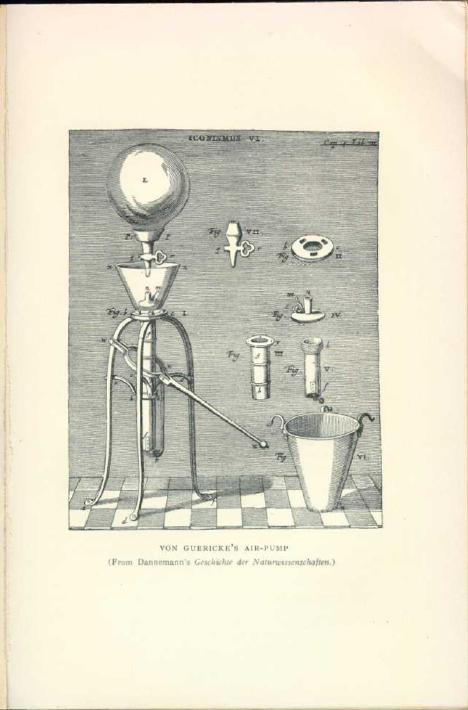
VON GUERICKE'S AIR-PUMP (From Dannemann's Geschichte der Naturwissenschaften.)
[Description: Illustration of von Guericke's air pump, from Dannemann's Geschichte der Naturwissenschaften. ]Von Guericke did not accept Gilbert's theory that the earth was a great magnet, but in his experiments along lines similar to those pursued by Gilbert, he not only invented the first electrical machine, but discovered electrical attraction and repulsion. The electrical machine which he invented consisted of a sphere of sulphur mounted on an iron axis to imitate the rotation of the earth, and which, when rubbed, manifested electrical reactions. When this globe was revolved and stroked with the dry hand it was found that it attached to it "all sorts of little fragments, like leaves of gold, silver, paper, etc.'' "Thus this globe,'' he says, "when brought rather near drops of water causes them to swell and puff up. It likewise attracts air, smoke, etc.''[38] Before the time of Guericke's demonstrations, Cabaeus had noted that chaff leaped back from an "electric,'' but he did not interpret the phenomenon as electrical repulsion. Von Guericke, however, recognized it as such, and refers to it as what he calls "expulsive virtue.'' "Even expulsive virtue is seen in this globe,'' he says, "for it not only attracts, but also repels again from itself little bodies of this sort, nor does it receive them until they have touched something else.'' It will be observed from this that he was
He performed a most interesting experiment with his sulphur globe and a feather, and in doing so came near anticipating Benjamin Franklin in his discovery of the effects of pointed conductors in drawing off the discharge. Having revolved and stroked his globe until it repelled a bit of down, he removed the globe from its rack and advancing it towards the now repellent down, drove it before him about the room. In this chase he observed that the down preferred to alight against "the points of any object whatsoever.'' He noticed that should the down chance to be driven within a few inches of a lighted candle, its attitude towards the globe suddenly changed, and instead of running away from it, it now "flew to it for protection'' —the charge on the down having been dissipated by the hot air. He also noted that if one face of a feather had been first attracted and then repelled by the sulphur ball, that the surface so affected was always turned towards the globe; so that if the positions of the two were reversed, the sides of the feather reversed also.
Still another important discovery, that of electrical conduction, was made by Von Guericke. Until his discovery no one had observed the transference of electricity from one body to another, although Gilbert had some time before noted that a rod rendered magnetic at one end became so at the other. Von Guericke's experiments were made upon a linen thread with his sulphur globe, which, he says, "having been
ROBERT HOOKE
A slender, crooked, shrivelled-limbed, cantankerous little man, with dishevelled hair and haggard countenance, bad-tempered and irritable, penurious and dishonest, at least in his claims for priority in discoveries—this is the picture usually drawn, alike by friends and enemies, of Robert Hooke (1635-1703), a man with an almost unparalleled genius for scientific discoveries in almost all branches of science. History gives few examples so striking of a man whose really great achievements in science would alone have made his name immortal, and yet who had the pusillanimous spirit of a charlatan—an almost insane mania, as it seems—for claiming the credit of discoveries made by others. This attitude of mind can hardly be explained except as a mania: it is certainly more charitable so to regard it. For his own discoveries and inventions were so numerous that a few more or less would hardly have added to his fame, as his reputation as a
It seems pretty definitely determined that Hooke should be credited with the invention of the balance-spring for regulating watches; but for a long time a heated controversy was waged between Hooke and Huygens as to who was the real inventor. It appears that Hooke conceived the idea of the balance-spring, while to Huygens belongs the credit of having adapted the coiled spring in a working model. He thus made practical Hooke's conception, which is without value except as applied by the coiled spring; but, nevertheless, the inventor, as well as the perfector, should receive credit. In this controversy, unlike many others, the blame cannot be laid at Hooke's door.
Hooke was the first curator of the Royal Society, and when anything was to be investigated, usually invented the mechanical devices for doing so. Astronomical apparatus, instruments for measuring specific weights, clocks and chronometers, methods of measuring the velocity of falling bodies, freezing and boiling points, strength of gunpowder, magnetic instruments—in short, all kinds of ingenious mechanical devices in all branches of science and mechanics. It was he who made the famous air-pump of Robert Boyle, based on Boyle's plans. Incidentally, Hooke claimed to be the inventor of the first air-pump himself, although this claim is now entirely discredited.
Within a period of two years he devised no less than thirty different methods of flying, all of which, of
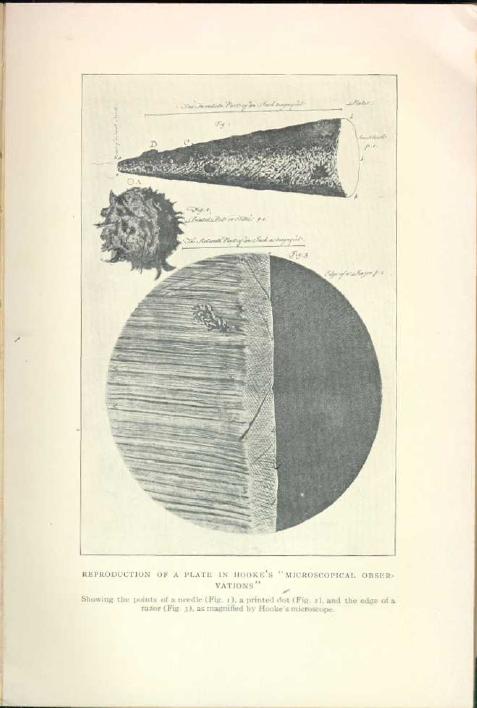
REPRODUCTION OF A PLATE IN HOOKE'S "MICROSCOPICAL
OBSERVATIONS''
Showing the points of a needle (Fig. 1), a printed dot
(Fig. 2), and the edge of a razor (Fig 3), as magnified
by Hooke's microscope.
[Description: Reproduction of a plate in Hooke's "Microscopical
Observations," showing the points of a needle (Fig. 1), a
printed dot (Fig. 2), and the edge of a razor (Fig 3), as
magnified by Hooke's microscope.
]
Hooke published, among other things, a book of plates and descriptions of his Microscopical Observations, which gives an idea of the advance that had already been made in microscopy in his time. Two of these plates are given here, which, even in this age of microscopy, are both interesting and instructive. These plates are made from prints of Hooke's original copper plates, and show that excellent lenses were made even at that time. They illustrate, also, how much might have been accomplished in the field of medicine if more attention had been given to microscopy by physicians. Even a century later, had physicians made better use of their microscopes, they could hardly have overlooked such an easily found parasite as the itch mite, which is quite as easily detected as the cheese mite, pictured in Hooke's book.
In justice to Hooke, and in extenuation of his otherwise inexcusable peculiarities of mind, it should be remembered that for many years he suffered from a
CHRISTIAN HUYGENS
If for nothing else, the world is indebted to the man who invented the pendulum clock, Christian Huygens (1629-1695), of the Hague, inventor, mathematician, mechanician, astronomer, and physicist. Huygens was the descendant of a noble and distinguished family, his father, Sir Constantine Huygens, being a well-known poet and diplomatist. Early in life young Huygens began his career in the legal profession, completing his education in the juridical school at Breda; but his taste for mathematics soon led him to neglect his legal studies, and his aptitude for scientific researches was so marked that Descartes predicted great things of him even while he was a mere tyro in the field of scientific investigation.
One of his first endeavors in science was to attempt an improvement of the telescope. Reflecting upon the process of making lenses then in vogue, young Huygens and his brother Constantine attempted a
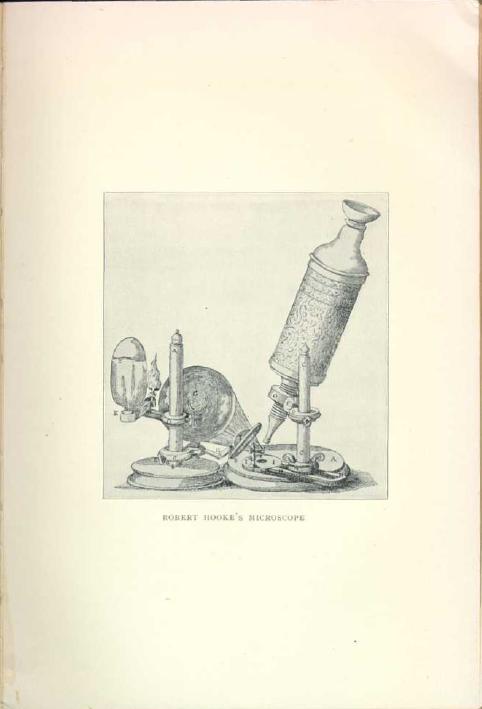
ROBERT HOOKE'S MICROSCOPE
[Description: Illustration of Robert Hooke's microscope. ]Huygens was one of the first to adapt the micrometer to the telescope—a mechanical device on which all the nice determination of minute distances depends. He also took up the controversy against Hooke as to the superiority of telescopic over plain sights to quadrants, Hooke contending in favor of the plain. In this controversy, the subject of which attracted wide attention, Huygens was completely victorious; and Hooke, being unable to refute Huygens's arguments, exhibited such irritability that he increased his already general unpopularity. All of the arguments for and against the telescope sight are too numerous to be given here. In contending in its favor Huygens pointed
In the field of optics, also, Huygens has added considerably to science, and his work, Dioptrics, is said to have been a favorite book with Newton. During the later part of his life, however, Huygens again devoted himself to inventing and constructing telescopes, grinding the lenses, and devising, if not actually making, the frame for holding them. These telescopes were of enormous lengths, three of his object-glasses, now in possession of the Royal Society, being of 123, 180, and 210 feet focal length respectively. Such instruments, if constructed in the ordinary form of the long tube, were very unmanageable, and to obviate this Huygens adopted the plan of dispensing with the tube altogether, mounting his lenses on long poles manipulated by machinery. Even these were unwieldy enough, but the difficulties of manipulation were fully compensated by the results obtained.
It had been discovered, among other things, that in oblique refraction light is separated into colors. Therefore, any small portion of the convex lens of the telescope, being a prism, the rays proceed to the focus, separated into prismatic colors, which make the image
In 1663 he was elected a fellow of the Royal Society of London, and in 1669 he gave to that body a concise statement of the laws governing the collision of elastic bodies. Although the same views had been given by Wallis and Wren a few weeks earlier, there is no doubt that Huygens's views were reached independently; and it is probable that he had arrived at his conclusions several years before. In the Philosophical Transactions for 1669 it is recorded that the society, being interested in the laws of the principles of motion, a request was made that M. Huygens, Dr. Wallis, and Sir Christopher Wren submit their views on the subject. Wallis submitted his paper first, November 15, 1668. A month later, December 17th, Wren imparted to the society his laws as to the nature of the collision of bodies. And a few days later, January 5, 1669, Huygens sent in his "Rules Concerning the Motion of Bodies after Mutual Impulse.'' Although Huygens's report was received last, he was anticipated by such a brief space of time, and his vews are so clearly stated
- "If a hard body should strike against a body equally hard at rest, after contact the former will rest and the latter acquire a velocity equal to that of the moving body.
- "But if that other equal body be likewise in motion, and moving in the same direction, after contact they will move with reciprocal velocities.
- "A body, however great, is moved by a body however small impelled with any velocity whatsoever.
- "The quantity of motion of two bodies may be either increased or diminished by their shock; but the same quantity towards the same part remains, after subtracting the quantity of the contrary motion.
- "The sum of the products arising from multiplying the mass of any hard body into the squares of its velocity is the same both before and after the stroke.
- "A hard body at rest will receive a greater quantity of motion from another hard body, either greater or less than itself, by the interposition of any third body of a mean quantity, than if it was immediately struck by the body itself; and if the interposing body be a mean proportional between the other two, its action upon the quiescent body will be the greatest of all.''[39]
This was only one of several interesting and important communications sent to the Royal Society during his lifetime. One of these was a report on what he calls "Pneumatical Experiments.'' "Upon including in a vacuum an insect resembling a beetle, but some-what
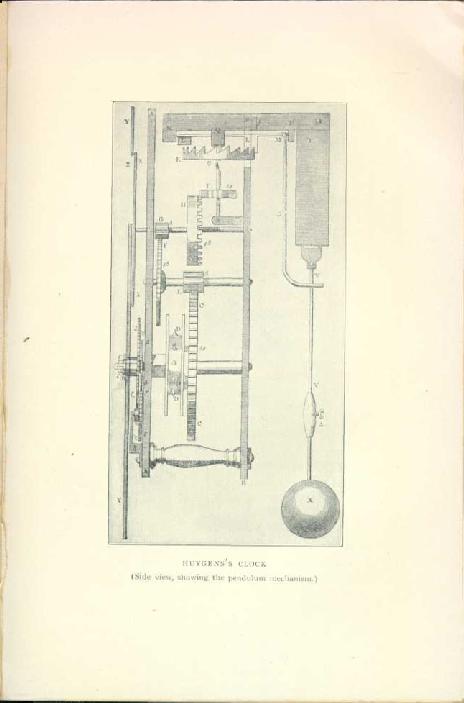
HUYGENS'S CLOCK
(Side view, showing the pendulum mechanism.)
[Description: Diagram of Huygen's clock, side view, showing the
pendulum mechanism.
]
From 1665 to 1681, accepting the tempting offer made him through Colbert, by Louis XIV., Huygens pursued his studies at the Bibliothèque du Roi as a resident of France. Here he published his Horologium Oscillatorium, dedicated to the king, containing, among other things, his solution of the problem of the "centre of oscillation.'' This in itself was an important step in the history of mechanics. Assuming as true that the centre of gravity of any number of interdependent bodies cannot rise higher than the point from which it falls, he reached correct conclusions as to the general principle of the conservation of vis viva, although he did not actually prove his conclusions. This was the first attempt to deal with the dynamics of a system. In this work, also, was the true determination of the relation between the length of a pendulum and the time of its oscillation.
In 1681 he returned to Holland, influenced, it is believed, by the attitude that was being taken in France against his religion. Here he continued his investigations, built his immense telescopes, and, among other things, discovered "polarization,'' which is recorded in Traité de la Lumière, published at Leyden in 1690. Five years later he died, bequeathing his manuscripts to the University of Leyden. It is interesting to note that he never accepted Newton's theory of gravitation as a universal property of matter.
Notes
| X
THE SUCCESSORS OF GALILEO IN PHYSICAL
SCIENCE
A History of Science: in Five Volumes. Volume II: The Beginnings of Modern Science | ||